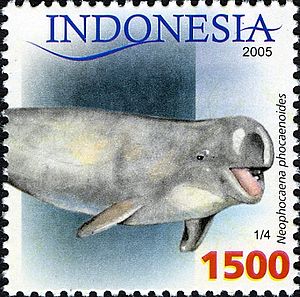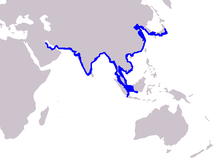Porpoise whales
| Porpoise whales | ||||||||||||
|---|---|---|---|---|---|---|---|---|---|---|---|---|

Porpoise ( Neophocaena phocaenoides ) on an Indonesian postage stamp |
||||||||||||
| Systematics | ||||||||||||
|
||||||||||||
| Scientific name | ||||||||||||
| Neophocaena | ||||||||||||
| Palmer , 1899 |
The porpoises ( Neophocaena ), also known as finless porpoises , are a genus of whales from the porpoise family (Phocoenidae). Their common German name is derived from the missing dorsal fin, which gives them a smooth, rounded appearance.
description
Porpoises are gray and sometimes a little lighter on the belly. Some individuals have a dark chin strap. The fin is missing from the porpoise, but the back is provided with a row of tubercles. These animals reach a length of 1.4 to 2.20 meters and a weight of 30 to over 45 kg. The head is small and clearly rounded by the melon . The flippers are slim and pointed, the crescent-shaped fluke has a clear notch.
Way of life
The porpoise is considered to be sedate. They roll to the surface of the water to breathe, and cracks are almost never observed. Dives are no longer than 11 to 15 seconds. They live in small groups that rarely consist of more than four animals. Their diet consists of fish , crustaceans (shrimp) and cephalopods . The young are born after a gestation period of 11 months and nursed for 6 to 15 months.
distribution
Porpoises live in the Asian coastal waters from the Persian Gulf to Japan , and are particularly common in Indian , Indonesian , Chinese and Japanese waters. They are also found in estuaries and even in rivers such as the Yangtze . In most cases, they are found in shallow water up to 50 meters deep.
Systematics
In the 18th century a total of four porpoise species were described, with the description being based in most cases on only one specimen. The genus was described in 1899 by the American zoologist Theodore Sherman Palmer . In the 20th century the genus was considered monotypical with Neophocaena phocaenoides as the only species. In 2011, a second species, already described in 1972, was revalidated and the genus Neophocaena was split into the species Neophocaena phocaenoides and Neophocaena asiaeorientalis . The latter has two subspecies: N. a. asiaeorientalis , which occurs very rarely in the Yangtze and the more common subspecies N. a. sunameri from South Korean and Japanese waters.
threat
There is not enough new data to accurately estimate the level of threat. Due to their way of life close to the coast, factors such as collisions with motor boats, ship noise, entanglement in fishing nets and pollution of the oceans pose dangers for the animals. Two studies, one from the late 1970s and one from 1999/2000 suggest that population and range of the genus have declined. The endangerment and decline in populations affects all species and subspecies known today. Scientists suggest that this decline has persisted for decades. In a census in 2006, around 1,100 to 1,200 specimens of the porpoise Neophocaena asiaeorientalis asiaeorientalis were counted in the Chinese river Yangtze . When counting a decade earlier, there were around 2,700 animals.
Individual evidence
- ^ Theodore Sherman Palmer: Notes on three genera of dolphins . In: Proceedings of the Biological Society of Washington . No. 13 , 1899, pp. 23–24 (English, biodiversitylibrary.org ).
- ↑ Yangtze Porpoise Species Profile, Background Information, WWF Germany , Department of Biodiversity, Species Conservation and TRAFFIC, Frankfurt am Main, June 2008, accessed on February 2, 2015
literature
- Rüdiger Wandrey: Whales and Seals of the World . Franckh-Kosmos Verlags GmbH, 1997, ISBN 3-440-07047-6
- TA Jefferson and JY Wang: Revision of the taxonomy of finless porpoises (genus Neophocaena): the existence of two species. Journal of Marine Animals and Their Ecology 4, pp. 3-16, 2011 PDF
Web links
- Yangtze river porpoise in the species lexicon of WWF Austria , accessed on February 2, 2015
